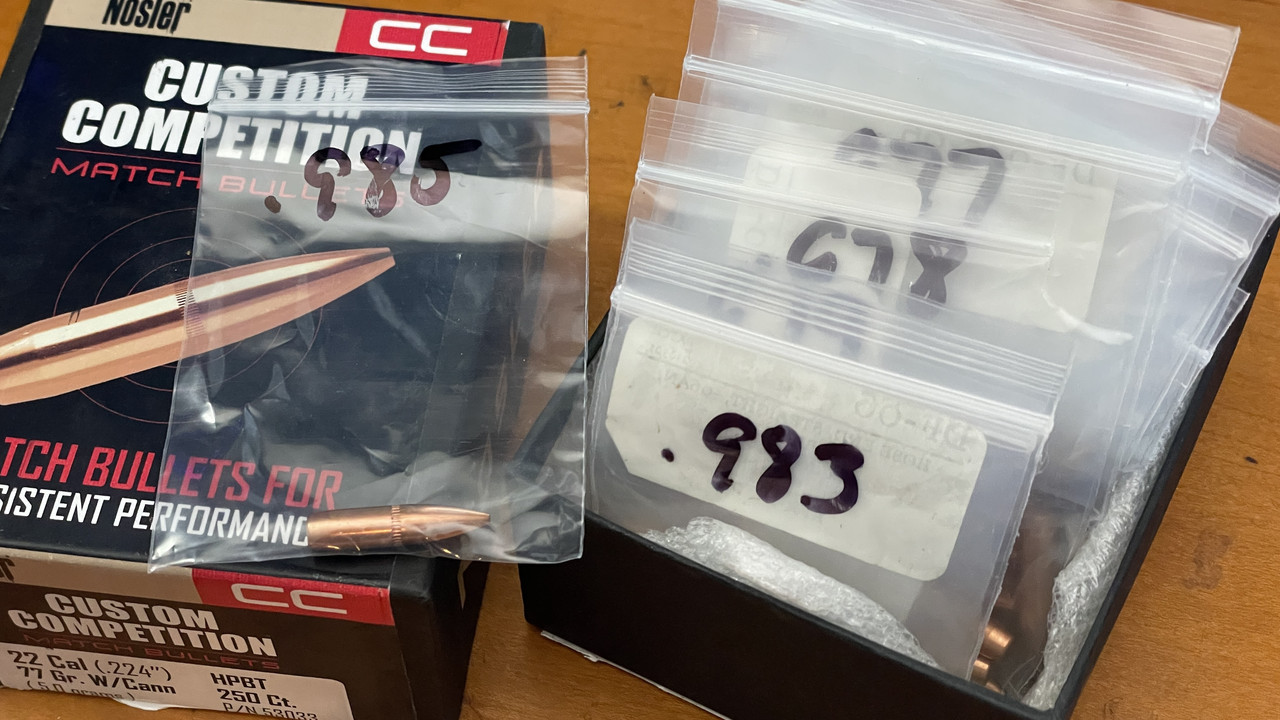Night hunting hogs with a 223/5.56 can be pretty tough. I switched ammo to the 75gr bthp hornady black and my hit to kill ratio went way up. Never shot the 77gr smk but I've got ten pounds of 2520 and 500 smk's to load so I'm going to give them a go.75 BTHPs kill much better than any of the 77 SMK loads I’ve tried. They shoot just as well too. I’ll stick with the 75 BTHP over the SMK, however the 77 TMK kills equally as well as the 75 BTHP in my experiment. However they’re harder to find.
Join the Hide community
Get access to live stream, lessons, the post exchange, and chat with other snipers.
Register
Download Gravity Ballistics
Get help to accurately calculate and scope your sniper rifle using real shooting data.

Install the app
How to install the app on iOS
Follow along with the video below to see how to install our site as a web app on your home screen.
Note: This feature may not be available in some browsers.
You are using an out of date browser. It may not display this or other websites correctly.
You should upgrade or use an alternative browser.
You should upgrade or use an alternative browser.
What's the best performing 223 AR load/bullet if you had to choose one?
- Thread starter AMMOWASTER
- Start date
25.6 of 8208 shoots great in all my 223s with the 53 v max. The 53 v max is the bullet I shoot the most. If the 70+ grain options were cheaper I would shoot them more but nickle or dime extra per bullet adds up.So far, a 53gr Hornady V-Max shoots very well out of a 18" Wylde barrel. 25gr of H335. Still need to try the heavier bullets.
I’m curious your terminal results with the SMK’s when you do. I’ve been using the 65 gr Sierra btsp on game in mine. They work very well, but I would like to have just one load with the 77 smk.Night hunting hogs with a 223/5.56 can be pretty tough. I switched ammo to the 75gr bthp hornady black and my hit to kill ratio went way up. Never shot the 77gr smk but I've got ten pounds of 2520 and 500 smk's to load so I'm going to give them a go.
the speer 75gr GD is really the only commercial projectile that actually answers the question. 77gr SMKs are great, and I will always have some handy, but if you’re after “one load, and only one load” then the 75gr SGD is the “one” if you’re buying in bulk. if availability goes out of the equation, then the answer becomes 855A1 (the fragmentation even at low velocity from a 10” is pretty stunning)
personally, I just keep a card with each rifle that records which ammunition is the “default zero” and the adjustments required to zero for a different load.
currently in my 5.56 bin there is a little of everything. 55 and 62gr bulk ammo (since the retro Irons are set for those) 77gr SMK and TMK for competition, a nice batch of Federal LE223T3 I managed to score that is the best ammo I’ve ever encountered in terms of barrier/terminal performance, and what I’d probably use in a “things have gone bad” scenario. Some actual 262 and 318 for comparison use, and the usual oddball assortment ofleftovers from stuff I’ve tried or keep meaning to try
personally, I just keep a card with each rifle that records which ammunition is the “default zero” and the adjustments required to zero for a different load.
currently in my 5.56 bin there is a little of everything. 55 and 62gr bulk ammo (since the retro Irons are set for those) 77gr SMK and TMK for competition, a nice batch of Federal LE223T3 I managed to score that is the best ammo I’ve ever encountered in terms of barrier/terminal performance, and what I’d probably use in a “things have gone bad” scenario. Some actual 262 and 318 for comparison use, and the usual oddball assortment ofleftovers from stuff I’ve tried or keep meaning to try
I've considered loading a mid 60gr projectile for bulk to have on hand. Should do plenty good to 4-500yards. I get hung up on these heavy for caliber bullets and think that's just what I've got to have but the soft points kill stuff pretty dead.I’m curious your terminal results with the SMK’s when you do. I’ve been using the 65 gr Sierra btsp on game in mine. They work very well, but I would like to have just one load with the 77 smk.
I thought the 64gr tmk might be a good one. People swear by the 77 so I'm going to see what its all about. I'll report back when I get to it
I've considered loading a mid 60gr projectile for bulk to have on hand. Should do plenty good to 4-500yards. I get hung up on these heavy for caliber bullets and think that's just what I've got to have but the soft points kill stuff pretty dead.
I thought the 64gr tmk might be a good one. People swear by the 77 so I'm going to see what its all about. I'll report back when I get to it
So I haven't tested the 64 TMK but I did some pretty extensive testing with 60 TMK's and they are stupid accurate and nasty out of my 16" Wilson Combat 5.56 1-8 AR...
Reloader 15
H4895
AR Comp
I've considered loading a mid 60gr projectile for bulk to have on hand. Should do plenty good to 4-500yards. I get hung up on these heavy for caliber bullets and think that's just what I've got to have but the soft points kill stuff pretty dead.
I thought the 64gr tmk might be a good one. People swear by the 77 so I'm going to see what its all about. I'll report back when I get to it
I can say I’ve been very pleased with the 65gr btsp hunting. 4 deer, 1 at 154 yards the other three between 225-270 yards. All but one passed through that I have a picture of here. Like you I’m just hung up on the heavy high bc bullets and would like to have one that’s as accurate as the 77smk but performs on game. In my 308 & 7 mag it was easy, Amax’s.
Here's some bullets I shot through pork shoulders and captured in jugs of water.
The six on the right are .223 out of a 14.5" AR at 100yds. The 5 that are intact are 62gr Speed Gold Dots. The 6th on the top left is a Hornady 55gr SP with cannuler. The all copper on the left is a Barnes 110gr TAC TX out of a 300BO going 2500fps. The large mushroom on the bottom left is a 6.5mm Speer 120gr Gold Dot going 2780fps.
I think there's something valuable in the bonded bullets
View attachment 8196548
Gotta love the 110 Tac TX in 300bo!! I did a similar test in wet phone books and denim recovered in water jugs and got the same results, also with 125TMK in 300blk.. just like a 9mm HST. TMK are nasty
Ha, funny you mention 9mm HSTs. I went through a whole phase last year testing 147gr 9mm bullets in subsonic. The HSTs were the best performers. Surprised how poorly the 147 Speer GDs did below 1050.
Hahah. Tested them as well! Love the HST....it's all I shoot and load in 9mm and 45 to mimic my carry ammo. The GD's shot like SHIT in my guns...found that out AFTER buying a 500rd case...sold the 450rd I had left
American Reloading has 9mm HST pulls frequently. I load them with N340 for practice to mimic my factory 147 HST carry ammo....I buy a few thousand each time they pop.in stock..
But these Xtreme 165gr are my hands down favorite subsonic 9mm round if quite is your goal and they hit steel like a freight train. Stupid quiet and accurate with N340..
Same place I got my HSTs. I did try those 165's. They weren't any quieter than the 147's or 158's for me but I was using Titegroup. I might try the N340 with them. Thanks for the tip.
No problem. N340 is my go to 9mm subs powder
I haven’t ran the 65 BTSPs at all, but I had a 65 Sierra Game King load that was my go to for quite some time. Haven’t shot it in 6-7 years I’d bet now, but I was more pleased with the 75 BTHP overall, so that’s been my go toI’m curious your terminal results with the SMK’s when you do. I’ve been using the 65 gr Sierra btsp on game in mine. They work very well, but I would like to have just one load with the 77 smk.
I haven’t ran the 65 BTSPs at all, but I had a 65 Sierra Game King load that was my go to for quite some time. Haven’t shot it in 6-7 years I’d bet now, but I was more pleased with the 75 BTHP overall, so that’s been my go to
The 65gr Sierra Game King is the 65 BTSP. Normally just called the 65 SGK though. It's a great all-around bullet for game and target shooting, if you don't need the last 100+ yards extra range of a 75/77gr.
One of my primary loads is that bullet:
65 SGK 2.215" OAL
WSR, LC brass
AA2460 25.8gr (2880 fps - 16" AR15)
The other is the Hornady 75gr BTHP:
75 BTHP 2.255" OAL
S&B SR, LC brass
Benchmark 23.5gr (2680 fps - 16" AR15)
This one is very consistent, but those S&B primers are no longer available. I haven't found anything else that shoots as well with this load. YMMV
Of course if you want speed with a 75gr or 77gr, Leverevolution is where it's at. There is no published data yet, but it works really well and is fairly easy to work up a good load, just be aware of temp sensitivity. Mine:
75 BTHP 2.255" OAL
CCI #41, LC brass
Lever 25.6gr (2740 fps - 16" AR15, well below max)
If you care to push it, this combo can do 2,800+ in a 16" with good brass life, and exceed 3,000 fps from a 20" barrel.
That’s spicy. I had some factory 73gr ELD-M Superformance that clocked > 3000 fps from my 20”, but they popped a few primers.….
75 BTHP 2.255" OAL
CCI #41, LC brass
Lever 25.6gr (2740 fps - 16" AR15, well below max)
If you care to push it, this combo can do 2,800+ in a 16" with good brass life, and exceed 3,000 fps from a 20" barrel.
I grabbed some 2000MR and Vihtavuori N540 to play with some hand loaded 80gr ELD-Ms. Hopefully one works out well. But I may try leverevolution.
For My rifles 68-69 Gr. punch single ragged holes at respectable distances for .224 caliber ,so never saw a need for heavier fodder . Although I do have 75 Gr. Match loads for better LR stability . Beyond that I step up in calibers .
That’s spicy. I had some factory 73gr ELD-M Superformance that clocked > 3000 fps from my 20”, but they popped a few primers.
I grabbed some 2000MR and Vihtavuori N540 to play with some hand loaded 80gr ELD-Ms. Hopefully one works out well. But I may try leverevolution.
Yeah, it's a little spicy in terms of speed, but judging by case signs (loosening primer pockets, brass OAL growth, etc) the top end with Leverevolution in a 20" with 75/77s is about 50-75+ fps faster than with TAC, depending on the bullet. I haven't worked much with Superformance in 5.56, but use Lever a lot - it's my go-to powder for speed because nothing else matches it in medium-heavy bullet 5.56 loads. CFE223 comes the closest but still lags behind a little, and it's less forgiving on the top end.
Lever is an interesting powder; there's not much data for it in most cartridges but it's super versatile and gives both top end speeds and great accuracy at max loads. (My load development with Lever starts with finding max load, back off slightly, then tune OAL; usually I can stop there without tuning the powder charge to find a "node" because it's almost always right at the max useable/safe load.)
Some of the cartridges I use it in where it performs really well:
5.56 (~65gr and up)
6mm ARC and 6mm Grendel variants
6.5 Grendel
308
30/30 (of course)
35 Remington
35 Whelen
It felt a little weird loading up a 35 Whelen case with Lever the first time, but once I worked up a good load - dayum. 225gr Partitions or Accubonds at 2950+ when they were running ~2580 in the same rifle with RL15. That made me sit up and take notice! BTW that 2000MR you mentioned is also a great 35 Whelen powder for 225-250gr loads.
The flip side of all this, of course, is the lack of data means you have to develop your own loads, basically the same as working with a wildcat cartridge. And the temp sensitivity - it's not necessarily linear or the same in all loads, but it can be very temp sensitive with big jumps above 70° F; be warned. However, I've found that if you work up a fast load in hot weather, then load to the same speed in the winter with Lever, you can expect more or less the same accuracy a lot of the time.
If you had to pick one load for general shooting target and possibly defense what would it be. Seems like a 75 or 77 grain load of some type is the most common choice. I still have a bunch of 77 Noslers I bought cheap so that's what I will probably start with. I know there's some newer bullets that people are using but they are usually a bit more spendy.
So what are you guys using? I might shoot an occasional match but not really a big thing for me. For me once I find a good load I'll just load a pile of it. Not looking for something on the edge just a good all around performer for multiple AR mag fed guns. Think everything I have is 1/7 or 1/8 at this point.
The 77 grain Nosler CC has better terminal ballistic properties than the 77 grain SMK, but it doesn't shoot as precisely in my barrels. It's accurate enough for my intended purpose for this projectile.
Nosler 77 grain Custom Competition
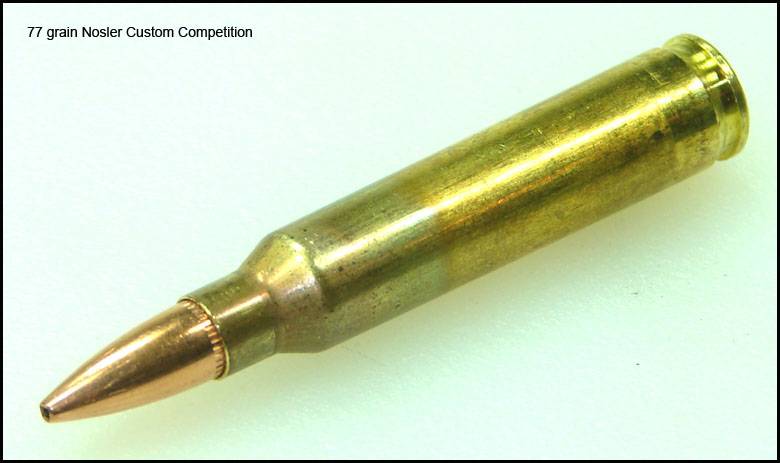
Nosler introduced their 77 grain Custom Competition BTHP bullet as an obvious competitor to the 77 grain Sierra MatchKing. The shape and ballistic coefficient of the Nosler bullet is very similar to that of the Sierra MatchKing. The Nosler bullet does have one major difference from the Sierra MatchKing; it is constructed using the thinner J4 copper jacket.
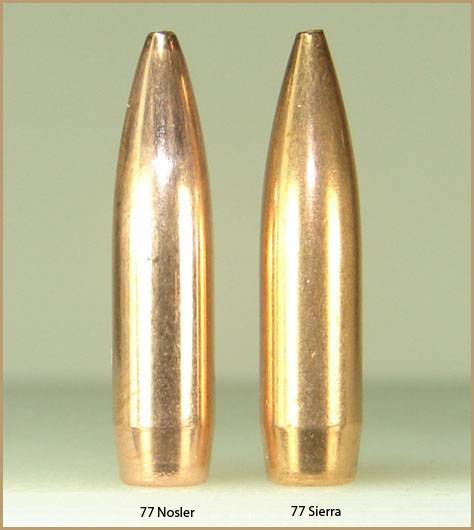
I recall an early Nosler advertisement for their Custom Competition bullet that included a phrase saying the bullet was “ideal for military and law enforcement,” hinting at the possibilities of improved fragmentation due to the thinner J4 jacket.
Thanks to the works of Dr. G.K. Roberts we know that the 77 grain Nosler bullet loaded to mil-spec velocities has superior terminal ballistic properties to that of the 77 grain Sierra MatchKing loaded in MK262. The terminal ballistic properties of the 77 grain Nosler bullet rival that of the Hornady 75 grain 5.56 TAP load. Unfortunately, there are no ammunition manufacturers that I’m aware of currently loading the 77 grain Nosler to mil-spec velocities.
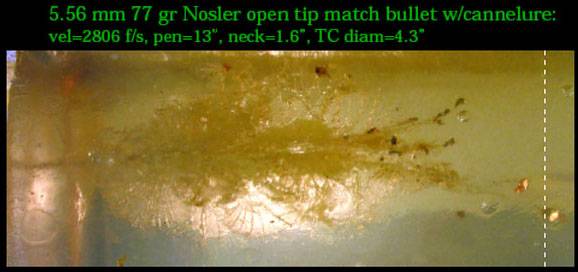
courtesy of Dr G.K. Roberts
The Nosler 77 grain Custom Competion bullet is typically sold without a cannelure, however Nosler occasionally releases the bullet with a shallow cannelure similar to the one found on the 77 grain SMK loaded in MK262. The cannelured version of the 77 grain Nosler will be the focus of this report.
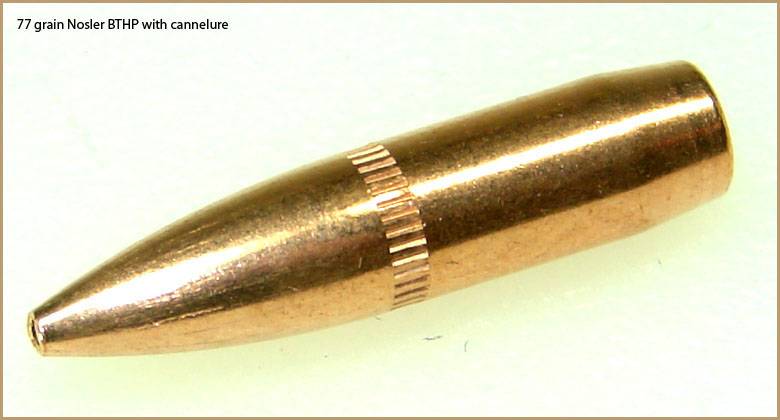
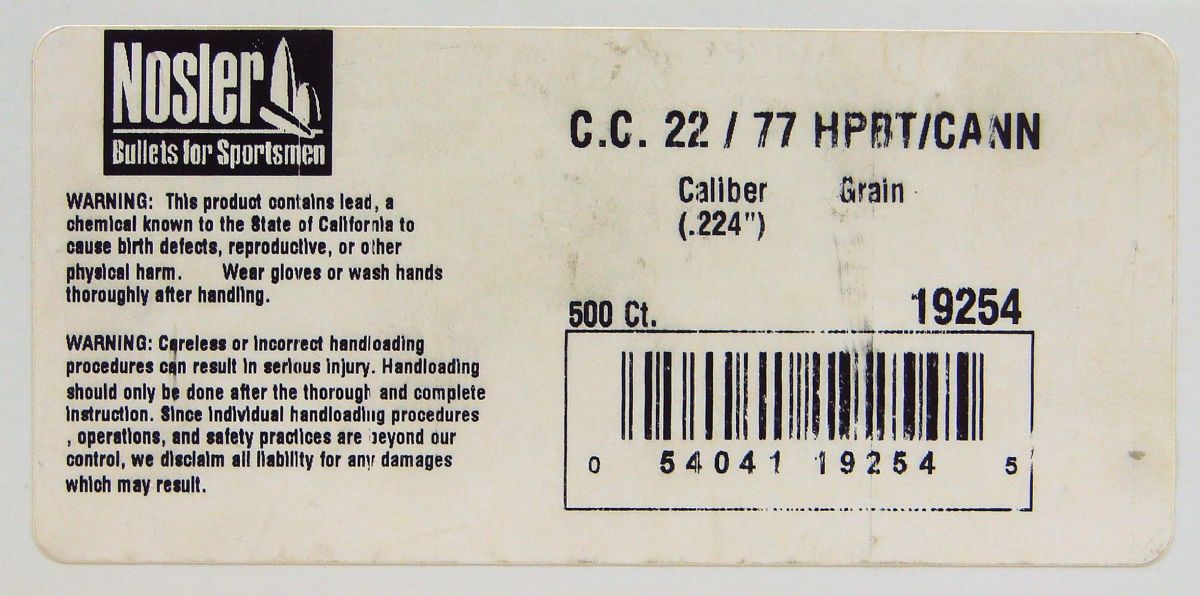
For the first phase of testing, I hand-loaded the cannelured version of the 77 grain Nosler BTHP to a typical SAAMI velocity (approximately 2600 fps from a 20” Colt barrel) to establish an accuracy baseline. No case mouth crimp was applied at this phase.
As per my usual protocol, accuracy testing was conducted from a concrete benchrest at a distance of 100 yards. For this phase of testing I used one of my 1:7.7” twist Krieger barreled AR-15s . This barrel has produced sub ½ MOA 10-shot groups with my hand-load topped with the Sierra 55 grain BlitzKing. The fore-end of the rifle rested in a Sinclair Windage Benchrest, while the stock of the rifle rode in a Protektor bunny-ear rear bag. A Leupold Competition Scope was used for testing. Wind conditions were monitored using a Wind Probe.
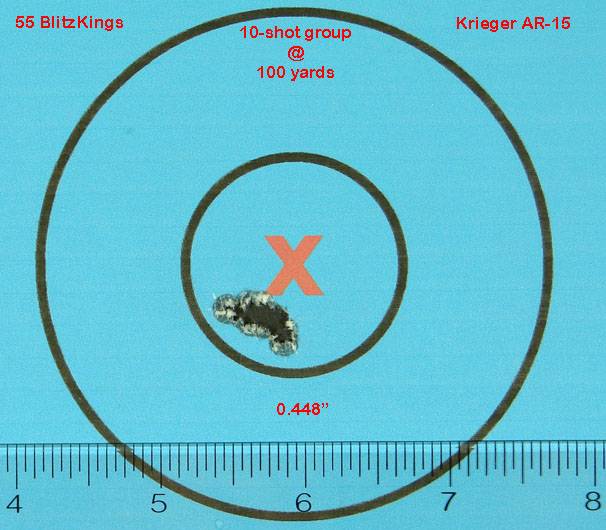
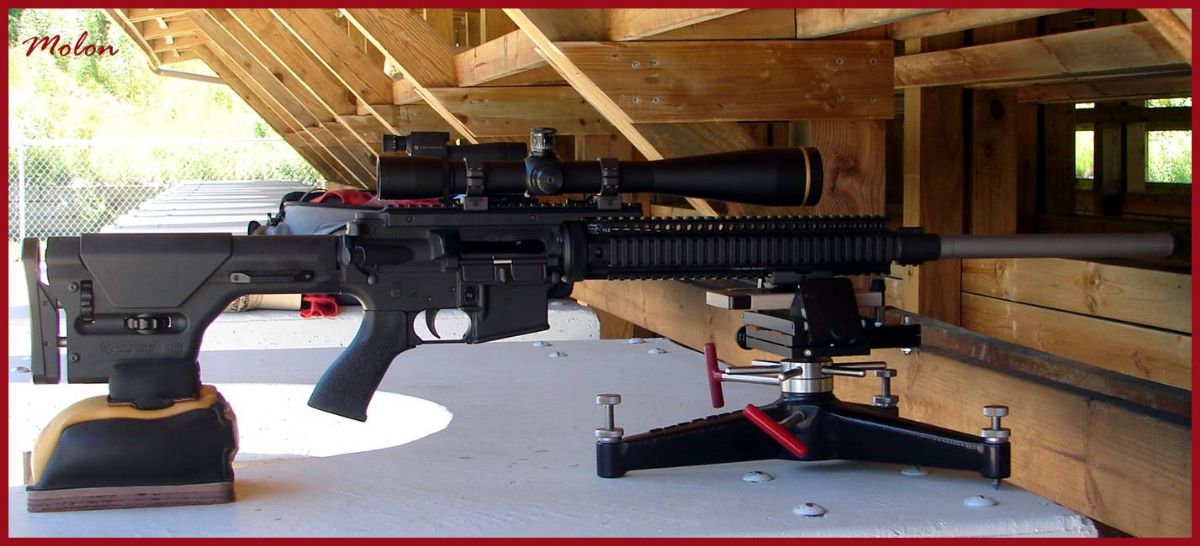
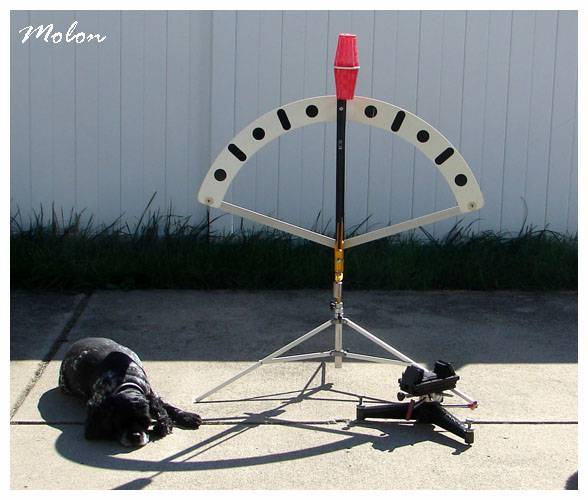
Three 10-shot groups were obtained which had extreme spreads of
0.797”
0.827”
0.812”
for a 10-shot group average of 0.812”. The three groups were over-layed on each other using RSI Shooting Lab to form a 30-shot composite group. The composite group had a mean radius of 0.26”. This test shows that the Nosler bullet itself is capable of consistent sub-MOA accuracy at 100 yards when fired from a semi-automatic AR-15.
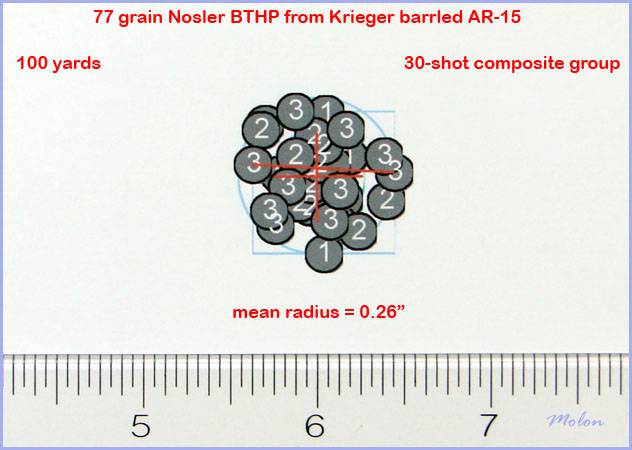
For the second phase of testing, I safely worked up a load for the 77 grain Nosler BTHP to a muzzle velocity of 2800 fps from a 20” barrel using a non-canister grade military powder which has a velocity-to-powder-charge ratio that is very close to that of the powder used in MK262. No case mouth crimp was used in this phase of testing either.
Since my Krieger barreled AR-15 has a 5.56mm Match chamber that is “a little too tight” for mil-spec pressure loads, I used my AR-15 with a 20” Noveske DCM barrel with a 1:7” twist for this phase of testing. This Noveske barrel has the “Noveske Match Mod 0 chamber which is designed to offer 100% reliability while retaining maximum possible accuracy. The chamber body is slightly larger than the 5.56mm NATO minimum, but within the 5.56 NATO tolerance. The throat is redesigned for proper bullet alignment with the axis of the bore. This chamber was developed to fire MK262 Mod 1 on AUTO in hot environments." This barrel has produced sub ¾ MOA groups with my 55 grain BlitzKing hand-load.
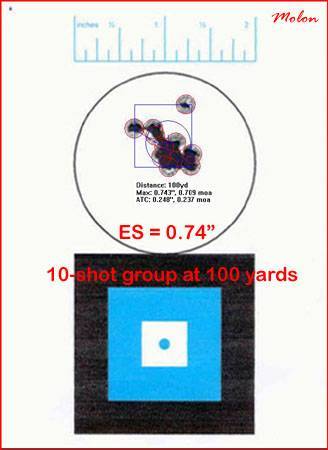

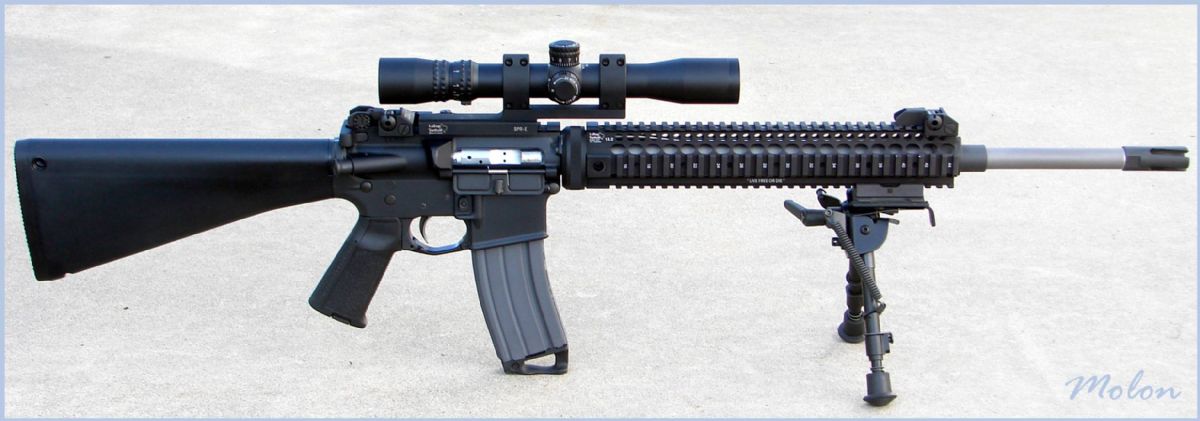
Accuracy testing using the Noveske barreled AR-15 and the mil-spec velocity load of Nosler 77 grain was conducted in the same manner as described above in the first phase of testing. Three 10-shot groups were obtained from 100 yards. Those groups had extreme spreads of:
0.880”
0.857”
0.845”
for a 10-shot group average of 0.860”! These groups were over-layed on each other using RSI Shooting Lab to form a 30-shot composite group which had a mean radius of 0.29”.
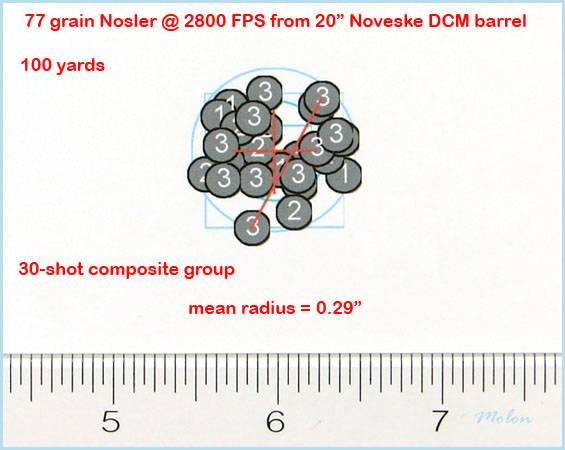
For the final phase of testing I added a taper crimp to the case mouth of the previously described load used in phase two. A 10-shot string of this load fired over the Oehler 35-P chronograph from my 20” Novekse barrel had a muzzle velocity of 2801 fps with a standard deviation of 12 fps.
Three 10-shot groups fired from 100 yards from the 20” Noveske DCM barrel had extreme spreads of:
1.033”
0.914”
1.241”
for a 10-shot group average of 1.063”. As before, the three groups were over-layed on each other using RSI Shooting Lab to form a 30-shot composite group. The mean radius for the composite group was 0.31”.
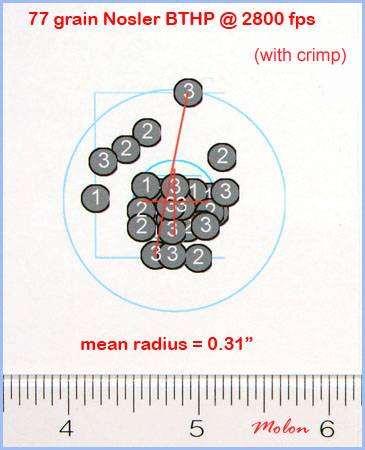
For comparison, Black Hills MK262 Mod 1 fired from my Lothar Walther barrel AR-15 had a 10-shot group average extreme spread of 1.098”. The mean radius for the 30-shot composite group of MK262 Mod 1 was 0.33”.
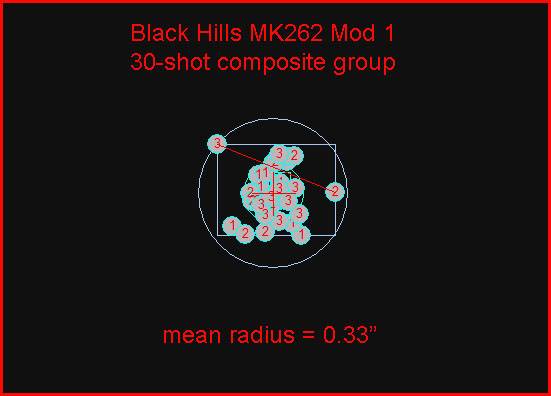
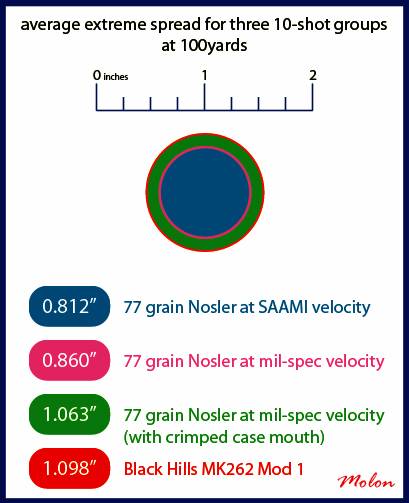
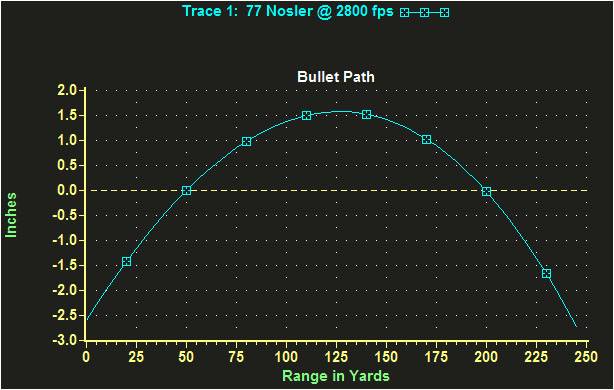
…..
Last edited:
Hornady 75 gr TAP shoots well in all my ARs and is a good performer. If I had to pick just one, I'd want a crap-ton of that.
The Federal 77 gr Gold Medal is just as accurate in my SPR, but I haven't tested it in the others yet.
That said, I'd rather a 5.56 load than a .223 for some applications.
I also like to use different rounds for different guns.
For an SBR, I like Federal 55 gr bonded.
For my patrol RECCE, the 77 gr IMI Razor Core.
For my SPR, the aforementioned 75 gr Hornady TAP.
The Federal 77 gr Gold Medal is just as accurate in my SPR, but I haven't tested it in the others yet.
That said, I'd rather a 5.56 load than a .223 for some applications.
I also like to use different rounds for different guns.
For an SBR, I like Federal 55 gr bonded.
For my patrol RECCE, the 77 gr IMI Razor Core.
For my SPR, the aforementioned 75 gr Hornady TAP.
75 grain Speer Gold Dot is the perfect "do it all" loading.
I don't know about "perfect" but it's certainly an excellent load.
Speer LE 75 Grain Gold Dot
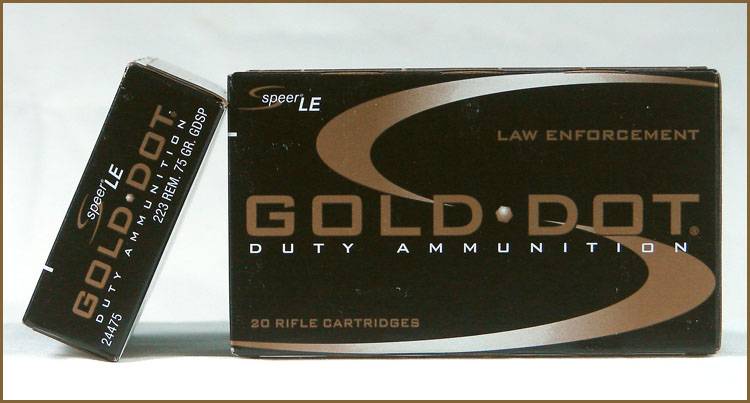
Following in the footsteps of their successful 62/64 grain Gold Dot LE 223 Remington ammunition, Speer has introduced a 75 grain version of their blind-to-barriers “bonded” soft-point load (#24475).
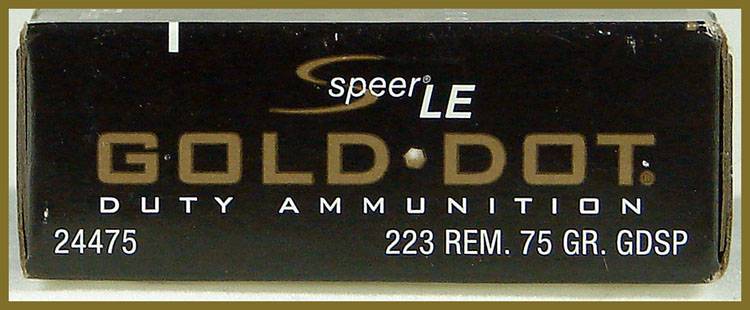
This ammunition is loaded in nickel-plated brass with crimped and sealed primers, however, there is no sealant at the case mouth. The load is charged with “ball” powder. The head-stamp reads:
“SPEER 15 223 REM”.
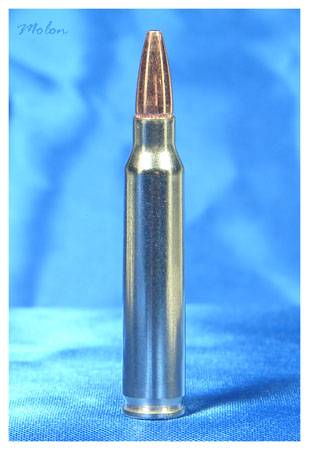
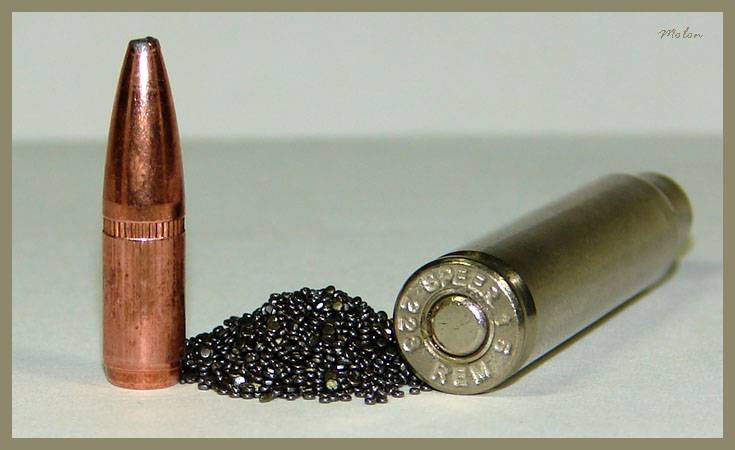
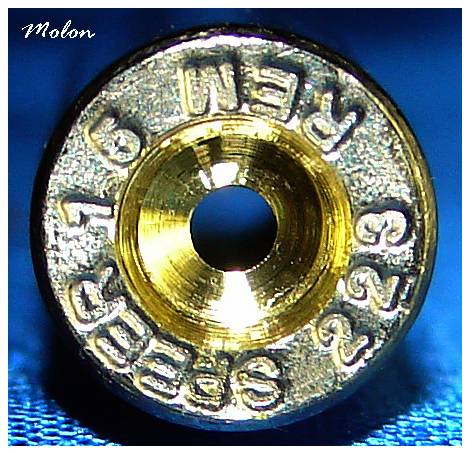
The form of the 75 grain Gold Dot is just what you would expect it to be, a longer and heavier version of the 62/64 grain Gold Dots.
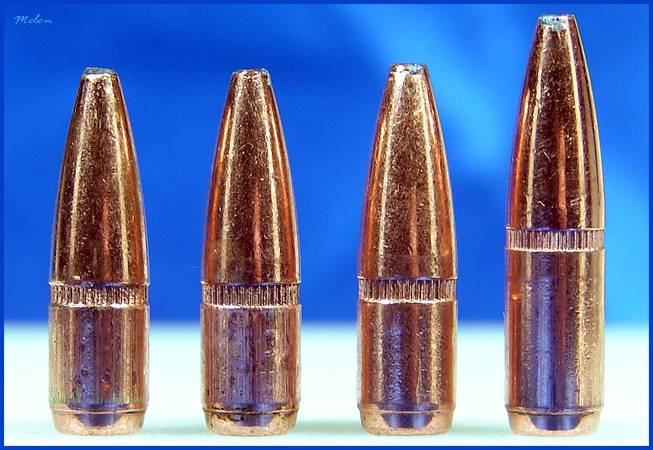
Left to right: 1) 62 grain Fusion, 2) 62 grain Gold Dot, 3) 64 grain Gold Dot, 4) 75 grain Gold Dot.
Accuracy
I conducted an accuracy (technically, precision) evaluation of the Speer LE 75 grain Gold Dot ammunition following my usual protocol. This accuracy evaluation used statistically significant shot-group sizes and every single shot in a fired group was included in the measurements. There was absolutely no use of any group-reduction techniques (e.g. fliers, target movement, butterfly shots).
The shooting set-up will be described in detail below. As many of the significant variables as was practicable were controlled for. Also, a control group was fired from the test-rifle used in the evaluation using match-grade, hand-loaded ammunition; in order to demonstrate the capability of the barrel. Pictures of shot-groups are posted for documentation.
All shooting was conducted from a concrete bench-rest from a distance of 100 yards (confirmed with a laser rangefinder.) The barrel used in the evaluation was free-floated. The free-float handguards of the rifle rested in a Sinclair Windage Benchrest, while the stock of the rifle rested in a Protektor bunny-ear rear bag. Sighting was accomplished via a Leupold Competition Series 45x45mm scope adjusted to be parallax-free at 100 yards. A mirage shield was used. Wind conditions on the shooting range were continuously monitored using a Wind Probe. The set-up was very similar to that pictured below.
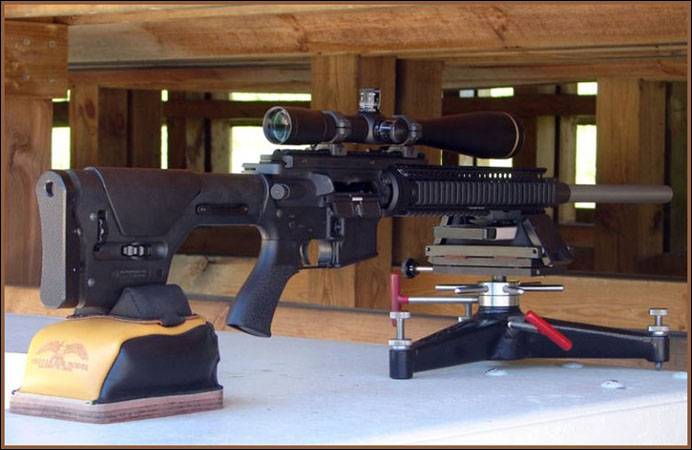
The Wind Probe.
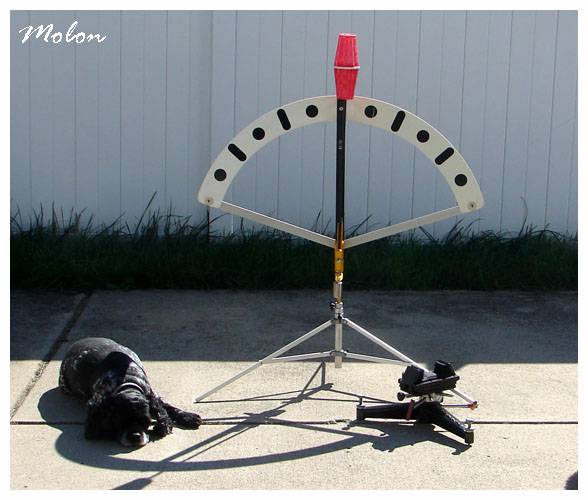
The test vehicle for this accuracy evaluation was one of my semi-automatic precision AR-15s with a 24” Krieger barrel. The barrel has a 5.56mm Match chamber with a 1:7.7” twist. Prior to firing the 75 grain Gold Dot ammunition, I fired a 10-shot control group using match-grade hand-loads topped with the Sierra 55 grain BlitzKing. That group had an extreme spread of 0.62”.
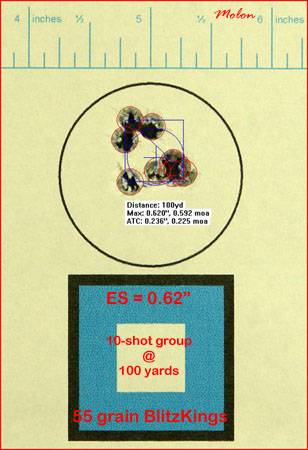
Three 10-shot groups of the Speer LE 75 grain Gold Dot ammunition were fired in a row with the resulting extreme spreads:
1.12”
1.03”
1.05”
for a 10-shot group average extreme spread of 1.07”. The three 10-shot groups were over-layed on each other using RSI Shooting Lab to form a 30-shot composite group. The mean radius for the 30-shot composite group was 0.32”.
The smallest 10-shot group . . .
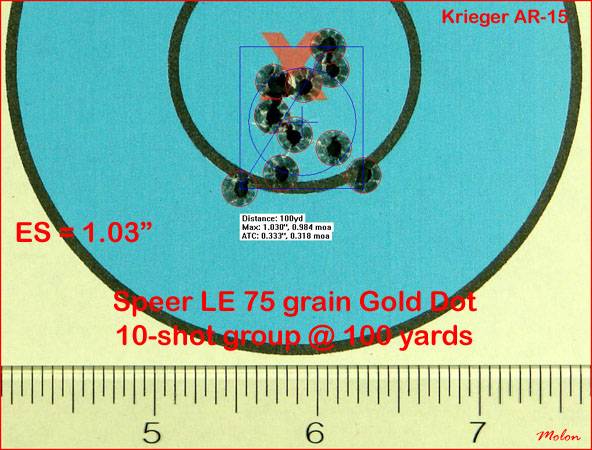
The 30-shot composite group . . .
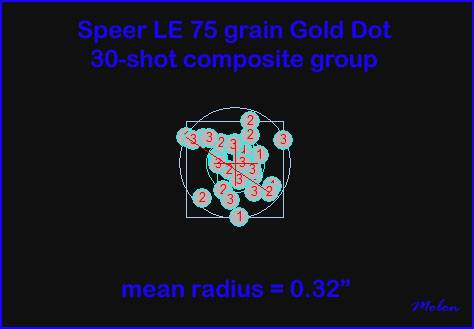
Velocity
I chronographed the Speer LE 75 grain Gold Dot ammunition from a semi-automatic AR-15 with a chrome-lined, NATO chambered, 20” Colt M16A2 barrel.
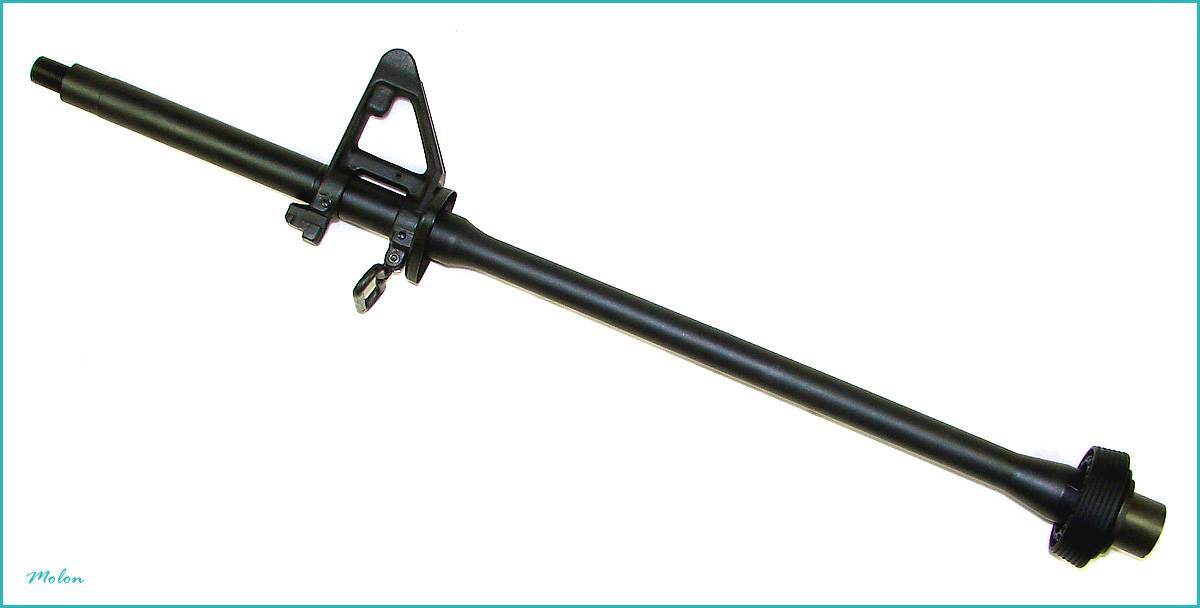
Chronographing was conducted using an Oehler 35-P chronograph with “proof screen” technology. The Oehler 35P chronograph is actually two chronographs in one package that takes two separate chronograph readings for each shot and then has its onboard computer analyze the data to determine if there is any statistically significant difference between the two readings. If there is a difference, the chronograph “flags” the shot to let you know that the data is invalid. There was no invalid data flagged during this testing.
The velocity stated below is the muzzle velocity as calculated from the instrumental velocity using Oehler’s Ballistic Explorer software program. The string of fire consisted of 10 rounds over the chronograph.
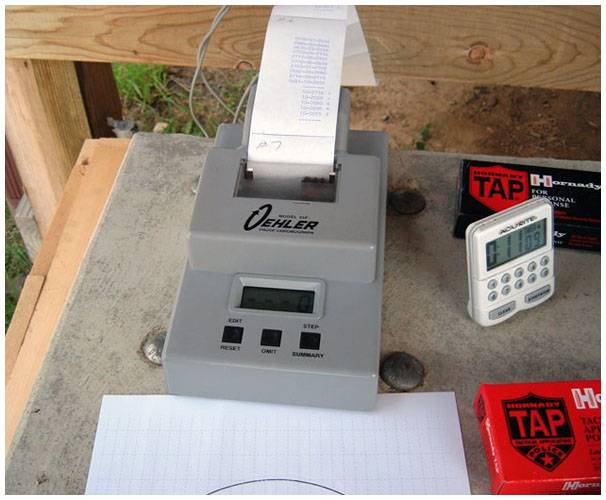
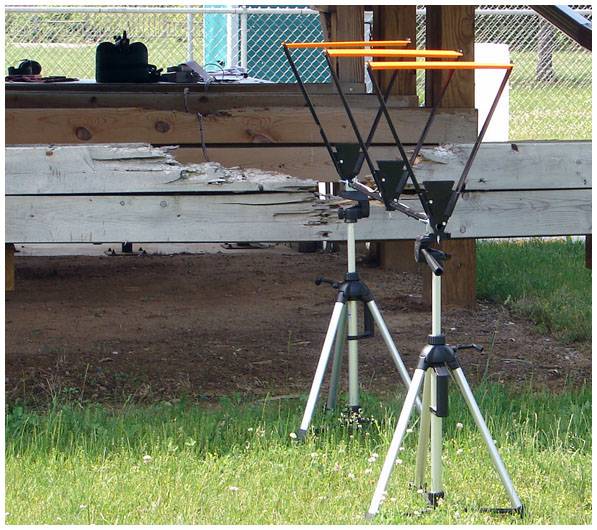
Each round was single-loaded and cycled into the chamber from a magazine fitted with a single-load follower. The bolt locked-back after each shot allowing the chamber to cool in between each shot. This technique was used to mitigate the possible influence of “chamber-soak” on velocity data. Each new shot was fired in a consistent manner after hitting the bolt release. Atmospheric conditions were monitored and recorded using a Kestrel 4000 Pocket Weather Tracker.
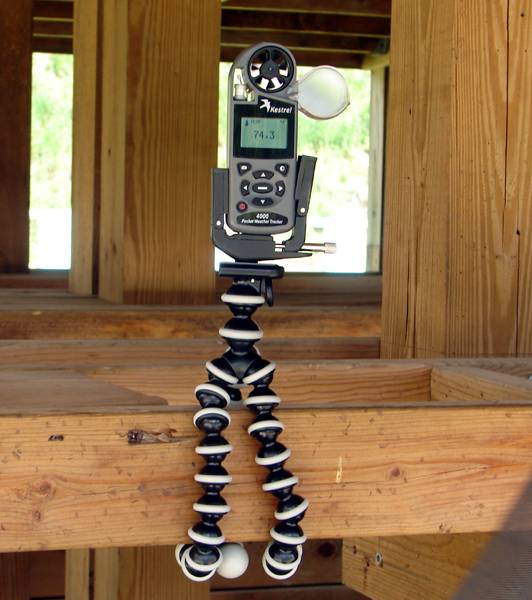
Atmospheric conditions
Temperature: 75 degrees F
Humidity: 33%
Barometric pressure: 30.05 inches of Hg
Elevation: 950 feet above sea level
The muzzle velocity for the 10-shot string of the Speer LE 75 grain Gold Dot ammunition fired from the 20” Colt barrel was 2652 FPS with a standard deviation of 11 FPS and a coefficient of variation of 0.42%.
For comparison, here's some additional chronograph data; this time from a Noveske 14.5" N4 barrel.
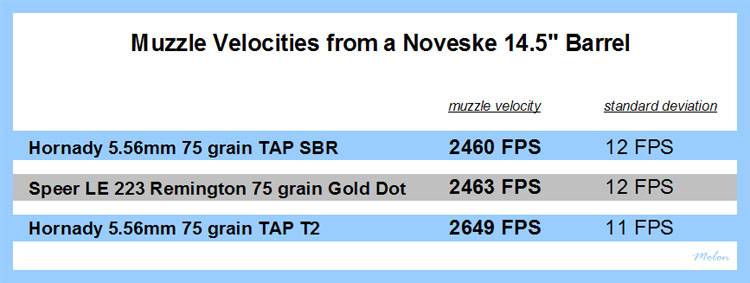
..
77 SMK with 23.2 N135 has been very accurate in my 18in CLE chambered Bartlien. cci41 primers ans LC brass sorted and weighed by headstamp.
That was actually the load I came up with for the 77 TMK’s so it’s been interchangeable for me.
I’ve also done really well with 23.4 Tac.
That was actually the load I came up with for the 77 TMK’s so it’s been interchangeable for me.
I’ve also done really well with 23.4 Tac.
@Molon, curious when you did the Nosler 77gr. test. I bought a big box and found the bullet OAL to be all over the map and wondering if QC has gone to shit recently. Very inconsistent in length and weight. Had pretty mediocre results. And what powder did you use? I didn't see any mention. I have a few available, 4046, Varget, Tac, H335.
I've since loaded 77gr. Bergers with TAC and found the combo to produce far tighter groups than the Noslers. My Noslers had a cannelure.
I've since loaded 77gr. Bergers with TAC and found the combo to produce far tighter groups than the Noslers. My Noslers had a cannelure.
I bought a big box and found the bullet OAL to be all over the map and wondering if QC has gone to shit recently. Very inconsistent in length and weight. Had pretty mediocre results. .
10 random bullets from the same lot that I tested . . .
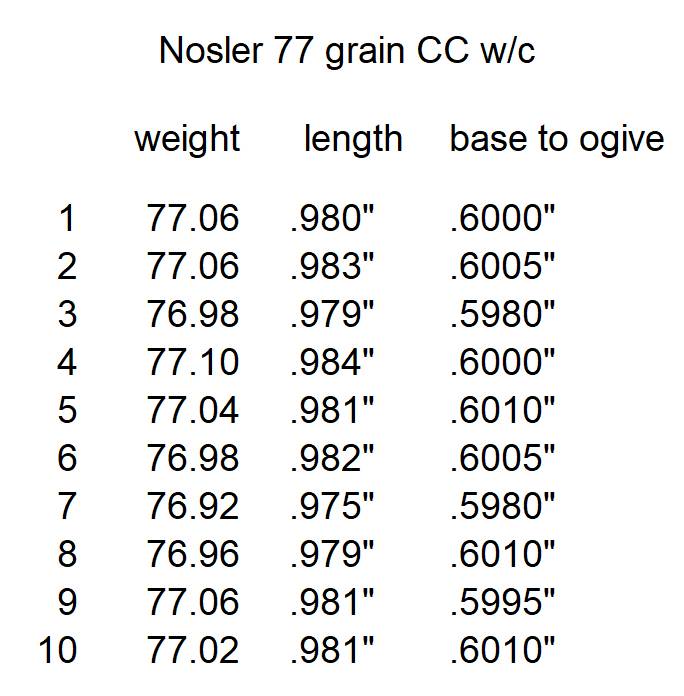
@Molon, curious when you did the Nosler 77gr. test. I bought a big box and found the bullet OAL to be all over the map and wondering if QC has gone to shit recently. Very inconsistent in length and weight. Had pretty mediocre results. And what powder did you use? I didn't see any mention. I have a few available, 4046, Varget, Tac, H335.
I've since loaded 77gr. Bergers with TAC and found the combo to produce far tighter groups than the Noslers. My Noslers had a cannelure.
Speaking for myself only - I’ve always had more trouble getting the Nosler 77 CC to shoot well than the 77 SMK or Hdy 75 BTHP. That may be my rifles ( multiple rifles, but always tried it in AR15s and other semi autos) but since I’ve consistently been able to get the 75 BTHP shooting well in everything with a bunch of different loads, and the 77 CC has consistently given me trouble from one box to the next, I’ve quit trying to use them. YMMV and no offense to those who like them.
Yeah that's pretty much my experience with them. I'll have to do another round of measurements but they were highly varied, more so than Molon's batch of 10.
did you ever get around to testing some 75gr rmr?I have a pet load for 1 of my 20" ar's that uses 77gr smks. I'm going to try so.e of those rmr 75gr hpbt and see how they do.
You guys will get a kick out of this...what your'e looking at are the Nosler 77 grain custom comps, with cannelure, sorted by length. Shortest at left, longest at right. Bought a box of 250 and this is all that's left after trying three different powders to get them to group decently. The disparity between them is pretty staggering. Shortest came in at .965 on my calipers, longest at .985. "Match bullets for consistent performance" is written on the box. Yeah, not so much. I didn't bother to weigh them but the ogive "only" varied by about .003 between bullets of any given length. After looking at the length disparity, the remainder will be loaded as plinkers, discarding the extreme outliers. Makes it tough when you're trying to load to mag length.


what in the crispy kentucky fried fuck is that kind of variance? Nosler owes you your $$ backYou guys will get a kick out of this...what your'e looking at are the Nosler 77 grain custom comps, with cannelure, sorted by length. Shortest at left, longest at right. Bought a box of 250 and this is all that's left after trying three different powders to get them to group decently. The disparity between them is pretty staggering. Shortest came in at .965 on my calipers, longest at .985. "Match bullets for consistent performance" is written on the box. Yeah, not so much. I didn't bother to weigh them but the ogive "only" varied by about .003 between bullets of any given length. After looking at the length disparity, the remainder will be loaded as plinkers, discarding the extreme outliers. Makes it tough when you're trying to load to mag length.

And that's just what's left over out of a box of 250. Who knows, maybe the spread was even larger. All the powder and primers(!) wasted...Berger FTW. I knew there was a reason they Noslers were on sale.
Nope. Factory packaging. P/N 53033. I'll shoot photo of box. I think the batch number is BT14F12-3/1141953953.Were they seconds?
I've only bothered to measure a handful of 77gr CC's. They weren't terribly consistent. But they shot great.
I cannot get them to shoot decently at over 2450fps out of a 12.5" barrel that produces sub MOA groupings with at least two other loads, 77gr. Bergers and 62gr. Hornady Vmax. Took 15 more tonight and using TAC, same results, nothing great, not even close to Berger in terms of accuracy. Same powder loads, brass, primers, etc... tested 23.9, 24.1 and 24.3gr, SD's in the mid to high 20's and up. Maybe 2 MOA at best at mag length.
Nosler 77s used to be 129 per 1000 for seconds. My load was 2.245" with 24gr of TAC in LC brass. They were/are used for mk262 ammunition and for 77 match loads by OEM companies. My guess is that the ammo companies have a way to uniform the tips of their loaded rounds to maintain a certain COAL or they discard the wacky ones.
Nosler varmint and ballistic tip bullets are much better. The 55grain ballistic tip group very tight out of my 22-250 using 34grains of varget. Their partition is arguably the best all around hunting bullet on the planet.
At current prices nosler "match" bullets aren't worth it vs hornady and sierra. JMHO.
Nosler varmint and ballistic tip bullets are much better. The 55grain ballistic tip group very tight out of my 22-250 using 34grains of varget. Their partition is arguably the best all around hunting bullet on the planet.
At current prices nosler "match" bullets aren't worth it vs hornady and sierra. JMHO.
The 5 that are intact are 62gr Speed Gold Dots.
The terminal ballistic properties of the 62/64 grain Gold Dot approaches that of the 62 grain Trophy Bonded Bear Claw and as you’ll see shortly, the 62 grain Gold Dot is considerably more accurate/precise than the TBBC. When handloaded, it is actually the most accurate/precise bonded soft-point bullet in that weight category that I’ve tested.
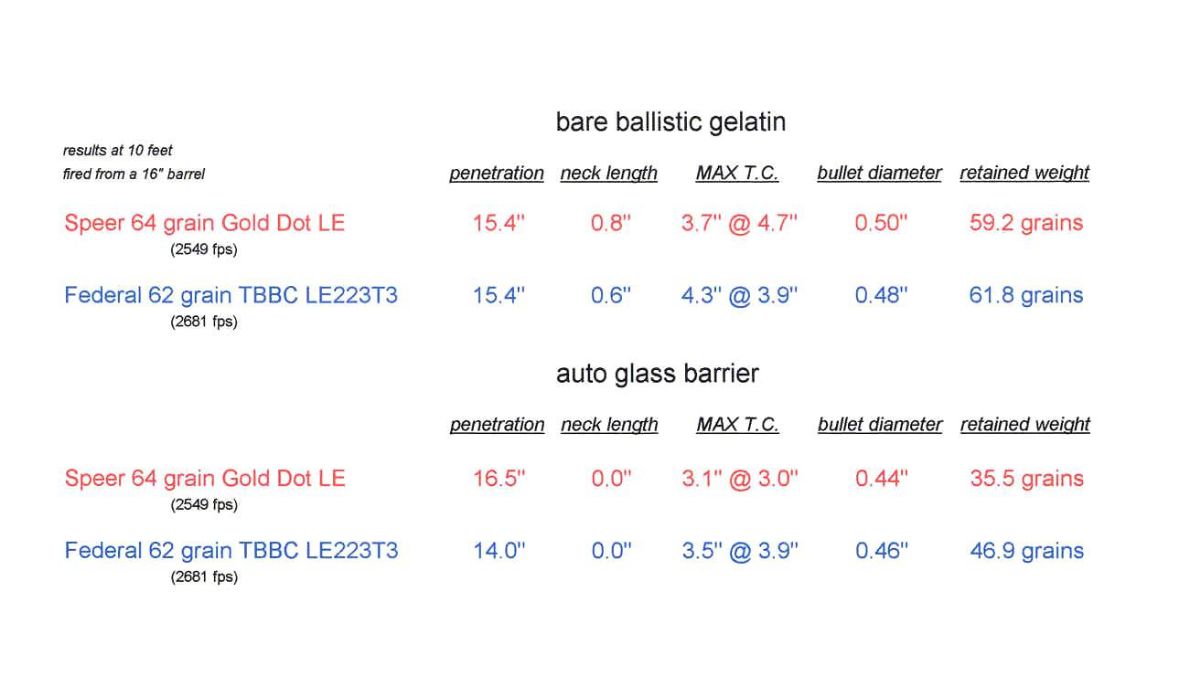
Three 10-shot groups of hand-load 62 grain Gold Dots fired from one of my precision AR-15s had the following extreme spreads:
0.662”
0.655”
0.581”
for an average extreme spread of 0.622”. The three 10-shot groups were over-layed on each other to form a 30-shot composite group. The mean radius for the 30-shot composite group was 0.215”.
The smallest 10-shot group . . .
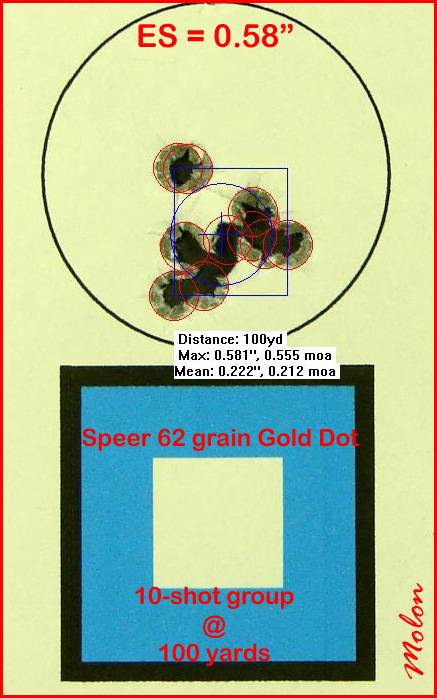
....
They finally got here today actually. Prob be a week or 2 before I do a workup and shoot themdid you ever get around to testing some 75gr rmr?
The GD's shot like SHIT in my guns...
While not as accurate as the HST, the 147 grain Gold Dot can do quite well when loaded to a nominal velocity of ~950 FPS.
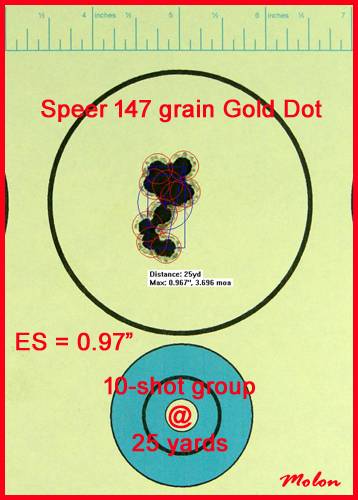
...
I shoot Noslers from their pro shop. Can’t beat their price and availability.The 77 grain Nosler CC has better terminal ballistic properties than the 77 grain SMK, but it doesn't shoot as precisely in my barrels. It's accurate enough for my intended purpose for this projectile.
Nosler 77 grain Custom Competition

Nosler introduced their 77 grain Custom Competition BTHP bullet as an obvious competitor to the 77 grain Sierra MatchKing. The shape and ballistic coefficient of the Nosler bullet is very similar to that of the Sierra MatchKing. The Nosler bullet does have one major difference from the Sierra MatchKing; it is constructed using the thinner J4 copper jacket.

I recall an early Nosler advertisement for their Custom Competition bullet that included a phrase saying the bullet was “ideal for military and law enforcement,” hinting at the possibilities of improved fragmentation due to the thinner J4 jacket.
Thanks to the works of Dr. G.K. Roberts we know that the 77 grain Nosler bullet loaded to mil-spec velocities has superior terminal ballistic properties to that of the 77 grain Sierra MatchKing loaded in MK262. The terminal ballistic properties of the 77 grain Nosler bullet rival that of the Hornady 75 grain 5.56 TAP load. Unfortunately, there are no ammunition manufacturers that I’m aware of currently loading the 77 grain Nosler to mil-spec velocities.

courtesy of Dr G.K. Roberts
The Nosler 77 grain Custom Competion bullet is typically sold without a cannelure, however Nosler occasionally releases the bullet with a shallow cannelure similar to the one found on the 77 grain SMK loaded in MK262. The cannelured version of the 77 grain Nosler will be the focus of this report.


For the first phase of testing, I hand-loaded the cannelured version of the 77 grain Nosler BTHP to a typical SAAMI velocity (approximately 2600 fps from a 20” Colt barrel) to establish an accuracy baseline. No case mouth crimp was applied at this phase.
As per my usual protocol, accuracy testing was conducted from a concrete benchrest at a distance of 100 yards. For this phase of testing I used one of my 1:7.7” twist Krieger barreled AR-15s . This barrel has produced sub ½ MOA 10-shot groups with my hand-load topped with the Sierra 55 grain BlitzKing. The fore-end of the rifle rested in a Sinclair Windage Benchrest, while the stock of the rifle rode in a Protektor bunny-ear rear bag. A Leupold Competition Scope was used for testing. Wind conditions were monitored using a Wind Probe.



Three 10-shot groups were obtained which had extreme spreads of
0.797”
0.827”
0.812”
for a 10-shot group average of 0.812”. The three groups were over-layed on each other using RSI Shooting Lab to form a 30-shot composite group. The composite group had a mean radius of 0.26”. This test shows that the Nosler bullet itself is capable of consistent sub-MOA accuracy at 100 yards when fired from a semi-automatic AR-15.

For the second phase of testing, I safely worked up a load for the 77 grain Nosler BTHP to a muzzle velocity of 2800 fps from a 20” barrel using a non-canister grade military powder which has a velocity-to-powder-charge ratio that is very close to that of the powder used in MK262. No case mouth crimp was used in this phase of testing either.
Since my Krieger barreled AR-15 has a 5.56mm Match chamber that is “a little too tight” for mil-spec pressure loads, I used my AR-15 with a 20” Noveske DCM barrel with a 1:7” twist for this phase of testing. This Noveske barrel has the “Noveske Match Mod 0 chamber which is designed to offer 100% reliability while retaining maximum possible accuracy. The chamber body is slightly larger than the 5.56mm NATO minimum, but within the 5.56 NATO tolerance. The throat is redesigned for proper bullet alignment with the axis of the bore. This chamber was developed to fire MK262 Mod 1 on AUTO in hot environments." This barrel has produced sub ¾ MOA groups with my 55 grain BlitzKing hand-load.



Accuracy testing using the Noveske barreled AR-15 and the mil-spec velocity load of Nosler 77 grain was conducted in the same manner as described above in the first phase of testing. Three 10-shot groups were obtained from 100 yards. Those groups had extreme spreads of:
0.880”
0.857”
0.845”
for a 10-shot group average of 0.860”! These groups were over-layed on each other using RSI Shooting Lab to form a 30-shot composite group which had a mean radius of 0.29”.

For the final phase of testing I added a taper crimp to the case mouth of the previously described load used in phase two. A 10-shot string of this load fired over the Oehler 35-P chronograph from my 20” Novekse barrel had a muzzle velocity of 2801 fps with a standard deviation of 12 fps.
Three 10-shot groups fired from 100 yards from the 20” Noveske DCM barrel had extreme spreads of:
1.033”
0.914”
1.241”
for a 10-shot group average of 1.063”. As before, the three groups were over-layed on each other using RSI Shooting Lab to form a 30-shot composite group. The mean radius for the composite group was 0.31”.

For comparison, Black Hills MK262 Mod 1 fired from my Lothar Walther barrel AR-15 had a 10-shot group average extreme spread of 1.098”. The mean radius for the 30-shot composite group of MK262 Mod 1 was 0.33”.



…..
Thing is a 5 shot group tends to be three together and two in a satellite group just next to it.
It will be 1 MOA or close so we’ll enough.
I had to run the 147 go dots all the way up to 1050 to get them to expand. That is the problem with them. They will not reliably expand at 950.
No doubt. My carry guns are all loaded with either 124 grain or 147 grain HSTs.
..
77 of your choice
23.2-23.4 XBR 8208
LC
SRM of your choice
You could use around 24 of:
Re15
Varget
TAC
23.2-23.4 XBR 8208
LC
SRM of your choice
You could use around 24 of:
Re15
Varget
TAC
62gr surplus green tips of course! I mean, you just can’t beat groups like this:
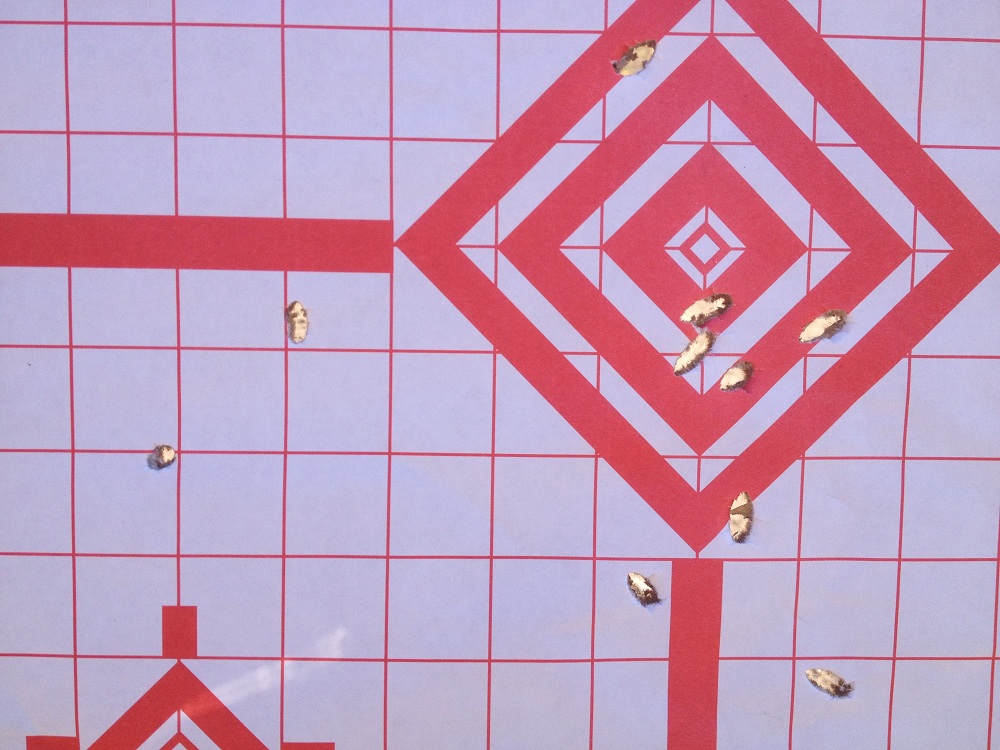
I kid of course…. Haven’t tried the SMKs, but 75-77 gr bullets in general have worked great for me for punching holes in paper, and general varmint eradication, up to and including feral hogs. Though if I’m specifically going after hogs, I’ll put on a 6.8 upper, or just grab something chambered in .308.

I kid of course…. Haven’t tried the SMKs, but 75-77 gr bullets in general have worked great for me for punching holes in paper, and general varmint eradication, up to and including feral hogs. Though if I’m specifically going after hogs, I’ll put on a 6.8 upper, or just grab something chambered in .308.
what unrifled garbage rod was that shot with?62gr surplus green tips of course! I mean, you just can’t beat groups like this:

I kid of course…. Haven’t tried the SMKs, but 75-77 gr bullets in general have worked great for me for punching holes in paper, and general varmint eradication, up to and including feral hogs. Though if I’m specifically going after hogs, I’ll put on a 6.8 upper, or just grab something chambered in .308.
IMHO for this user case, its very hard to overlook the Hornday HPBT 69/75.If I start shooting seriously I will consider some premium bullets.
You really need to be paying attention and/or shooting high value targets to "consciously outshoot" a 69 or 75HPBT <600 yards, and at which stage by definition you are seriously IMHO.
+1 LOL. OP wants cheap and easy. Presumably, he also wants readily available.I like how people casually throw out 8208. Pretty sure if anyone has 8208 it's because they stockpiled it they know exactly how to use it and don't need recommendations for a 75gr bullet, lol.
I have some Varget but don't think I have any 8208. I almost grabbed some numerous times because I know people that had great luck with it but I wasn't loading rifle stuff at the time so I let it go. Once it all got bad I quit trying to grab stuff because people really needed it. I'm much luckier than most in what I was able to gather. I'm never in a hurry.
A friend of mine has about 10 lbs of xbr and hasn't reloaded in a few years. He was alittle tight on $ and sold me 5 of them at what he paid for them ($23/lb). Needless to say, i am using it sparingly.
A friend of mine has about 10 lbs of xbr and hasn't reloaded in a few years. He was alittle tight on $ and sold me 5 of them at what he paid for them ($23/lb). Needless to say, i am using it sparingly.
I still have nearly 8 lb of 8208 that I bought from a friend as well, but I've developed loads with VV-N540, VV-140, AR-Comp & 2000-MR that all perform as well or better than 8208 with 69/77's.
Both 540 & the 2000-MR give a little higher velocity, with 140 & AR-Comp doing about the same as 8208.
540 & 140 do a little bit better on accuracy as 8208; 2000-MR & AR-Comp are about the same. All are good enough for my needs.
With 55 & 60 grain bullets, VV-133 has consistently given me the best accuracy.
VV-N540 & 133 are pretty available right now, 2000-MR & AR-Comp come & go, VV-140 is unobtanium again right now though.
TAC, while not always the very best in either velocity or super fine accuracy, is still very good, cheap (by today's standards) & is readily available, especially for banging or hoser loads.
JME
MM
Both 540 & the 2000-MR give a little higher velocity, with 140 & AR-Comp doing about the same as 8208.
540 & 140 do a little bit better on accuracy as 8208; 2000-MR & AR-Comp are about the same. All are good enough for my needs.
With 55 & 60 grain bullets, VV-133 has consistently given me the best accuracy.
VV-N540 & 133 are pretty available right now, 2000-MR & AR-Comp come & go, VV-140 is unobtanium again right now though.
TAC, while not always the very best in either velocity or super fine accuracy, is still very good, cheap (by today's standards) & is readily available, especially for banging or hoser loads.
JME
MM
8208 has been readily available around here in several of our main gun shops until about a month ago. Not sure why some of you guys think it's unobtanium.
No idea why anyone would think TAC is a substitute though. Other than being a similar burn rate, they have very little in common; 8208 is a temp stable stick powder that works great with moderate loads, while TAC is a very temp sensitive ball powder that works best with hotter loads. 8208 for precision ammo, TAC for duplicating mil-surp ball.
No idea why anyone would think TAC is a substitute though. Other than being a similar burn rate, they have very little in common; 8208 is a temp stable stick powder that works great with moderate loads, while TAC is a very temp sensitive ball powder that works best with hotter loads. 8208 for precision ammo, TAC for duplicating mil-surp ball.
Similar threads
- Replies
- 4
- Views
- 489
- Replies
- 67
- Views
- 2K
- Replies
- 64
- Views
- 3K




